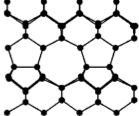 Comment on "a/[110] Stacking Fault Model for Platelets in Diamond"
Comment on "a/[110] Stacking Fault Model for Platelets in Diamond"
Recently, Miranda et al. [1] introduced a new model for the platelet in diamond based on a a/4[110] shear of (001) planes. The shear produces a stacking fault whereby the normal [001] stacking of AaBbAaBb, etc. becomes AaaAbBaA. The a/4[110] shear is not equivalent to the addition of a (001) plane of interstitials which until now has been the basis for platelet models. After the a/4[110] shear across the (001) plane, atoms connecting the two a planes have coplanar neighbor bonds and are thus double bonded. The π-bonding orbitals so formed are separated from others by the second neighbor distance in diamond (2.5Å).
We believe there is ample evidence in the literature which rules out the model of Miranda et al. and at the same time strongly supports a model based on a (001) layer of carbon interstitials which had been proposed long ago [2–4] and had recently been supported by first principles modeling studies [5].
(1) Electron microscopic studies [3,6] have shown that the displacement vector of the platelet is normal to the [001] habit excluding a a/4[110] shear. Indeed, Humble, on page 70 of Ref. [3], specifically comments that his data exclude such a shear. This immediately rules out the stacking fault model.
(2) The displacement caused by the fault along (001) is not the length of the π-bond (1.35Å), as claimed in Ref. [1], but the difference between this bond length and the normal C–C spacing along [110]; i.e., the displacement is 0.129a and consequently far from the measured value of 0.3a–0.4a [3].
(3) Platelets are formed in heat treated type-I, nitrogen-rich diamonds and there is a linear relationship observed between the platelet area and the concentration of certain vacancy-nitrogen complexes [2]. This is easily explained by a model where the platelet contains an additional (001) layer of carbon interstitials but has no direct link with the stacking fault model which does not contain any additional atoms.
(4) The [110] and [11̅0] directions in the a/4[110] stacking fault possess distinct bonding patterns. This non-equivalence would lead to platelets being elongated along one of these directions. In fact, observations show platelets possess only a slight asymmetry between the two directions [7].
In conclusion, the model of Miranda is inconsistent with much of the experimental literature on the platelet, whereas the interstitial model introduced by Humble [3] and Woods [4] and supported by ab initio studies by Goss [5] explains most of the current data.
- C. R. Miranda, A. Antonelli, and R. W. Nunes, Physical Review Letters 93, 265502 (2004).
- G. S. Woods, Philos. Mag. 34, 993 (1976).
- P. Humble, Proc. R. Soc. A 381, 65 (1982).
- G. S. Woods, Proc. R. Soc. A 407, 219 (1986).
- J. P. Goss, B. J. Coomer, R. Jones, C. J. Fall, P. R. Briddon, and S. Öberg, Physical Review B 67, 165208 (2003).
- P.B. Hirsch, P. Pirouz, and J.C. Barry, Proc. R. Soc. A 407, 239 (1986).
- P. J. Fallon, L. M. Brown, J. C. Barry, and J. Bruley, Philos. Mag. A 72, 21 (1995).